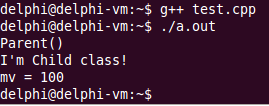C++深度解析 继承的概念和意义(42)
类之间的关系:组合、继承。
组合关系:整体与部分的关系

示例程序:(组合关系的描述)
#include <iostream>
#include <string>
using namespace std;
class Memory
{
public:
Memory()
{
cout << "Memory()" << endl;
}
~Memory()
{
cout << "~Memory()" << endl;
}
};
class Disk
{
public:
Disk()
{
cout << "Disk()" << endl;
}
~Disk()
{
cout << "~Disk()" << endl;
}
};
class CPU
{
public:
CPU()
{
cout << "CPU()" << endl;
}
~CPU()
{
cout << "~CPU()" << endl;
}
};
class MainBoard
{
public:
MainBoard()
{
cout << "MainBoard()" << endl;
}
~MainBoard()
{
cout << "~MainBoard()" << endl;
}
};
class Computer
{
Memory mMem;
Disk mDisk;
CPU mCPU;
MainBoard mMainBoard;
public:
Computer()
{
cout << "Computer()" << endl;
}
void power()
{
cout << "power()" << endl;
}
void reset()
{
cout << "reset()" << endl;
}
~Computer()
{
cout << "~Computer()" << endl;
}
};
int main()
{
Computer c;
return 0;
}结果如下:

组合关系的特点
将其他类的对象作为当前类的成员使用
当前类的对象与成员对象的生命期相同
成员对象在用法上与普通对象完全一致
继承关系:父子关系
面向对象中的继承 指 类之间的父子关系
子类拥有父类的所有属性和行为
子类就是一种特殊的父类
子类对象可以当作父类对象使用
子类中可以添加父类没有的方法和属性
class Parent
{
int mv;
public:
void method() { };
};
class Child : public Parent //描述继承关系
{
};示例程序:
#include <iostream>
#include <string>
using namespace std;
class Parent
{
int mv;
public:
Parent()
{
cout << "Parent()" << endl;
mv = 100;
}
void method()
{
cout << "mv = " << mv << endl;
}
};
class Child : public Parent
{
public:
void hello()
{
cout << "I'm Child class!" << endl;
}
};
int main()
{
Child c;
c.hello();
c.method();
return 0;
}
结果如下:

分析:由于Child类继承Parent类,所以在创建Child类对象时,Parent()会被调用。
重要规则:
子类就是一个特殊的父类
子类对象可以直接初始化父类对象
子类对象可以直接赋值给父类对象
示例程序:
#include <iostream>
#include <string>
using namespace std;
class Parent
{
int mv;
public:
Parent()
{
cout << "Parent()" << endl;
mv = 100;
}
void method()
{
cout << "mv = " << mv << endl;
}
};
class Child : public Parent
{
public:
void hello()
{
cout << "I'm Child class!" << endl;
}
};
int main()
{
Child c;
Parent p1 = c;
Parent p2;
c.hello();
c.method();
p2 = c;
return 0;
}
继承的意义:
继承是C++中代码复用的重要手段。通过继承,可以获得父类的所有功能,并且可以在子类中重写已有功能,或者添加新功能。
示例程序:
#include <iostream>
#include <string>
using namespace std;
class Memory
{
public:
Memory()
{
cout << "Memory()" << endl;
}
~Memory()
{
cout << "~Memory()" << endl;
}
};
class Disk
{
public:
Disk()
{
cout << "Disk()" << endl;
}
~Disk()
{
cout << "~Disk()" << endl;
}
};
class CPU
{
public:
CPU()
{
cout << "CPU()" << endl;
}
~CPU()
{
cout << "~CPU()" << endl;
}
};
class MainBoard
{
public:
MainBoard()
{
cout << "MainBoard()" << endl;
}
~MainBoard()
{
cout << "~MainBoard()" << endl;
}
};
class Computer
{
Memory mMem;
Disk mDisk;
CPU mCPU;
MainBoard mMainBoard;
public:
Computer()
{
cout << "Computer()" << endl;
}
void power()
{
cout << "power()" << endl;
}
void reset()
{
cout << "reset()" << endl;
}
~Computer()
{
cout << "~Computer()" << endl;
}
};
class HPBook : public Computer
{
string mOS;
public:
HPBook()
{
mOS = "Windows 8";
}
void install(string os)
{
mOS = os;
}
void OS()
{
cout << mOS << endl;
}
};
class MacBook : public Computer
{
public:
void OS()
{
cout << "Mac OS" << endl;
}
};
int main()
{
HPBook hp;
hp.power();
hp.install("Ubuntu 16.04 LTS");
hp.OS();
cout << endl;
MacBook mac;
mac.OS();
return 0;
}结果如下:

小结
继承是面向对象中类之间的一种关系
子类拥有父类的所有属性和行为
子类对象可以当作父类对象使用
子类中可以添加父类没有的方法和属性
继承是面向对象中代码复用的重要手段
























 6万+
6万+











 被折叠的 条评论
为什么被折叠?
被折叠的 条评论
为什么被折叠?








